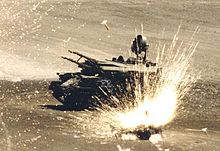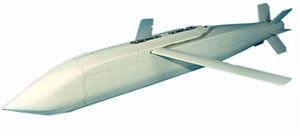AGM-154 Joint Standoff Weapon
The AGM-154 Joint Standoff Weapon (JSOW) is a precision-guided glide bomb that is primarily used by the US armed forces . It is produced by the US Corporation Raytheon .
history

The development of the AGM-154 JSOW originally began in 1986 when the US Navy started the "Advanced Interdiction Weapon System" program. The aim was to develop a precision-guided Fire & Forget stand -off weapon to replace the laser-guided weapons AGM-123 Skipper II , AGM-65E Maverick and Paveway . In June 1992 Texas Instruments (armaments division now part of Raytheon) won the tender and was commissioned to manufacture some demonstration models of the AGM-154A. In the same year the AIWS was merged with a similar program of the US Air Force and has since been referred to as the "Joint Standoff Weapon". The specifications now called for a cheap, lightweight weapon with a range of at least 9 km when dropped from a low height. A qualification for the so-called “lock-on after launch” (LOAL) procedure was also required, which enables the bomb to recognize and fight the target independently after being dropped through the carrier platform. Since a large number of different targets were to be fought, a modular warhead was also part of the list of demands. As a solution, Texas Instruments developed a glide bomb with a GPS / INS control. The first controlled test launch took place in December 1994 and in February 1997 the US Navy began operational testing, which was completed after 44 tests with a success rate of 96%. The initial combat readiness ( "initial operating capability" IOC) has reached the 1999th Series production began in the same year.
In February 2006, Raytheon received the David Packard Excellence in Acquisition Award, the US Department of Defense's highest award for a development and procurement program, for excellent project management .
Currently (as of August 2008) there are a total of 546 orders for the AGM-154A (231 for the US Navy, 315 for the US Air Force) and 421 for the AGM-154C. The unit price ranges from 300,000 to 350,000 US dollars , depending on the variant . By October 2010 a total of 3500 JSOWs had been delivered and over 400 had been used in combat.
technology
Two swivel blades serve as the primary source for the necessary lift , the position control is carried out by four small cross-shaped blades at the stern as well as two small horizontal control surfaces. The GPS / INS navigation system achieves a CEP of less than three meters. By means of a data link, the JSOW can also be subsequently supplied with new data after being dropped by a compatible platform. Compared to similar bombs, the cell has a significantly lower radar and infrared signature ( stealth technology ) in order to be able to bypass or combat modern air defense systems, for example 9K330 Tor or S-300P .
variants
AGM-154A
This is the first operational variant of the JSOW and has already been used over 400 times, especially in Iraq and Afghanistan . It uses an ejection system for 145 BLU-97 / B cluster bombs , each weighing 1.54 kg. These can fight both " soft targets " and lightly armored targets, as they have a fragmentation and a shaped charge warhead .
AGM-154A-1
This version builds on the Block II configuration and provides the AGM-154A with a BLU-111 warhead, which is essentially based on the Mark 82 bomb. This is intended for the fight against bunkered or hardened targets, which is why it is located in a solid steel housing . The warhead weighs 227 kg and contains 83 kg of explosives , and production began in 2006.
Block II
In June 2007 Raytheon delivered the first revised "Block II" variant. This version is more than 25% cheaper due to optimized manufacturing processes and a modified design. The bomb also features an improved inertial navigation system and a new, interference-free GPS receiver. All future A and C variants, as well as their sub-versions, will be manufactured on the basis of the Block II standard.
AGM-154B
The AGM-154B contains six BLU-108 / B "Sensor Fuzed Munitions" warheads for fighting moving, heavily armored targets. After the small rocket motor has burned out and a certain height has been reached, each warhead releases four more submunitions, known as skeets. These have a dual band infrared sensor that searches for targets independently and then fights them with a shaped charge warhead.
Development of this version has been completed, but the Air Force has given up its involvement in this project, which has resulted in the Navy suspending its procurement until further notice.
AGM-154C

This variant is built exclusively for the Navy. It has an additional FLIR sensor that works in the low infrared spectrum and has automatic target recognition to achieve even greater precision (CEP: 1.2 meters). The BROACH warhead from BAE Systems is used, which can also effectively fight heavily hardened targets. Series production has been running since December 2004.
AGM-154C-1
The primary feature of this version (which was previously called "JSOW Block III") is the two-way data link ( WDL ), which enables the dropping platform to receive various status reports from the bomb via a UHF or Link 16 data link to send new commands. With further improvements to the target recognition algorithm and the infrared seeker head, which were extensively tested in 2005 and 2006, it is now also possible to effectively combat moving ground and especially sea targets. AGM-154C-1 has a range of over 100 km and uses a shaped charge warhead . On March 13, Raytheon was awarded an order to manufacture and ship 280 AGM-154C-1s for a total of $ 107 million. Initial Operating Capability was achieved in mid-June 2016 .
AGM-154D
In this version, which is based on the AGM-154A model and is sometimes referred to as "JSOW-ER", a Williams WJ24-8 turbojet with 1.07 kN thrust is used to increase the range .
AGM-154E
Similar to the D version, but based on the AGM-154C model.
Platforms
- F-15E Strike Eagle 1
- F-16 Fighting Falcon 1
- F / A-18 Hornet 1
- F-35 Lightning II
- B-1B Lancer
- B-2 Spirit 1
- B-52 Stratofortress 1
- P-3 Orion
- Eurofighter
- Saab JAS-39 Gripen
- Panavia tornado
1 Complete integration completed (as of August 2008)
Technical specifications
| system | AGM-154A | AGM-154A-1 | AGM-154B | AGM-154C | AGM-154C-1 | AGM-154D | AGM-154E |
|---|---|---|---|---|---|---|---|
| length | 4.1 m | ||||||
| span | 2.69 m | ||||||
| width | 0.34 m | ||||||
| Takeoff weight | depending on the variant approx. 475 kg | ||||||
| drive | none | WJ24-8 turbojet | |||||
| speed | Subsonic | ||||||
| Range | Drop height 12 km: 115–130 km | 290 km | |||||
| steering | GPS , INS , data link | GPS, INS, FLIR , data link |
GPS, INS, FLIR, UHF / Link 16 2-way data link |
GPS, INS, data link | GPS, INS, FLIR, data link |
||
| Warhead | 145 × BLU-97 / B | BLU-111 | 6 × BLU-108 | BROACH | including BROACH | 145 × BLU-97 / B | BROACH |
Web links
Individual evidence
- ^ Defense Industry Daily - USA Issues JSOW Block III Production Contracts
- ↑ a b Jane's Defense Weekly June 6, 2007, p. 32
- ^ A b Richard Scott: JSOW C-1 achieves IOC. (No longer available online.) In: janes.com. June 21, 2016, archived from the original on June 25, 2016 ; accessed on June 24, 2016 .
- ^ Defense Industry Daily - USA Issues JSOW Block III Production Contracts , accessed March 19, 2009



